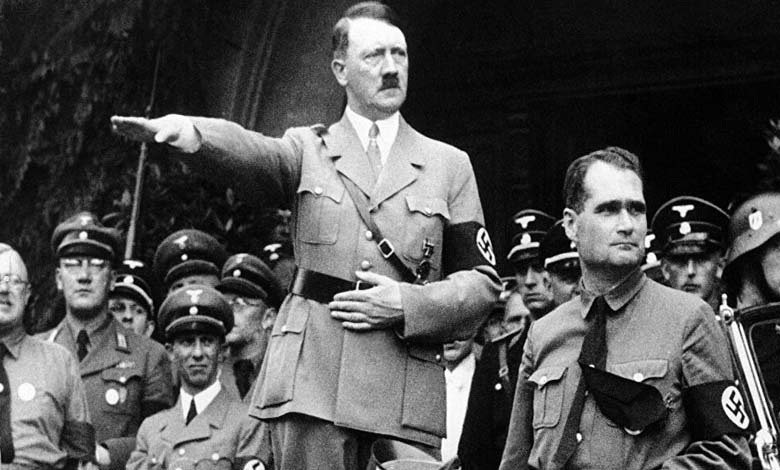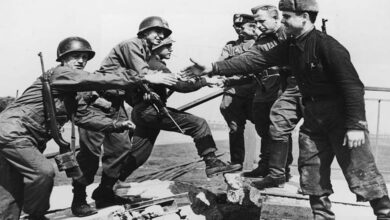Hitler’s Lost Gold… a German treasure hunter nears a breakthrough in an 80-year-old mystery

Eight decades after the end of World War II, the legend of “Hitler’s Lost Gold” has returned to the spotlight with German treasure hunter Cornelia Oestler announcing that she is close to solving one of the greatest historical riddles to have fascinated the world.
Oestler says she has found new evidence confirming that part of the Reichsbank’s hoard remains buried in the Bavarian Alps. She declares confidently, “I am certain I’m closing in on a major discovery,” according to the British newspaper The Sun.
The story begins in the final weeks of Adolf Hitler’s life, as Berlin collapsed under the Allied advance. Convoys left the capital for Bavaria’s south, carrying the last of the Nazis’ plunder in a desperate attempt to keep the spoils out of enemy hands.
-
The “Beer Hall Putsch”: The Bullet That Brought Luck to Hitler
-
Japan Doubles Shelters… Preparing for World War III?
Those convoys were loaded with hundreds of gold bars and dozens of chests filled
with rare coins, as well as millions of dollars in foreign currency—valued today in the billions of pounds sterling.
Accounts indicate that these treasures were buried in the Walchensee area, a pristine mountain lake in the Alps. Part of the cache was later recovered, while the larger portion has remained an unsolved mystery.
American soldiers carrying Hitler’s gold
“The chaos of the war’s last days was immense; much was moved or buried in haste. It’s likely that some of the treasure was never found—and perhaps some discoveries were deliberately concealed. History is full of gaps, and those gaps are what I’m trying to explore,” says Oestler, 40.
-
The Last Moments in the Life of the ‘Desert Fox’… Poison Tears Through His Entrails
-
From Istanbul to Rome: The Brotherhood Seeks Control
The story was documented by historian Ian Sayer with his colleague Douglas Botting in their well-known book, Nazi Gold, which revealed startling details about gold-smuggling operations in the spring of 1945.
At that time, the Allies seized more than 93 percent of Germany’s gold reserves at the Merkers mine in central Germany, while the remainder was, on Hitler’s orders, spirited away to Bavaria.
Shipments moved by road and rail amid fierce fighting before reaching Munich—where orders ceased.
“When the convoys reached Munich, no one knew what to do. They had lost contact with their command, and Hitler or Himmler could no longer be reached,” Sayer says.
American soldiers carrying Hitler’s gold
Over time, the hoard was transported to a mountain troops training facility in Mittenwald near the Austrian border, then sent to Einsiedl on the shores of Lake Walchensee, where it was hidden in the head forester’s large house.
By estimates, more than 11 tonnes of gold and valuables accumulated at this site, which later became a firing range attached to a youth hostel.
On the night of 26 April 1945, the loot was loaded onto mules, taken into the mountains, and buried at several sites in an area known as Steinriegl.
A few days later, as fears grew that the area would fall, the hoard was reburied in new locations to conceal it more thoroughly.
-
Updating Nuclear Shelters: Switzerland Prepares for a “World War Scenario”
-
World War II Deception: A Japanese Military Ship in the California Desert
Reports indicate that U.S. forces later managed to recover part of the wealth, but with precise records lacking, the amount found versus what remains buried is unknown.
Historian Sayer maintains that “a great deal of treasure is still missing,” noting that “many people took part in the transports, each carrying different amounts of gold and currency, which led to confusion and poor record-keeping.”
For Cornelia, every thread of evidence brings her closer to discovery. Her most notable find so far is a Nazi badge dating from 1934, which she believes is field evidence that the correct site is very close.
Oestler is working in direct coordination with historian Sayer, who in the 1990s located two missing bars that were displayed at the Bank of England fifty years after their disappearance.
He believes, however, that a substantial portion of the original hoard was stolen in the immediate post-war period.
-
Ukrainian Incursion in the Largest Attack on Russia Since World War II: What Is Happening on the Border?
-
World War II: The Strangest and Most Failed Weapons
American soldiers carrying Hitler’s gold
In his book, he cites a rumor circulating in the Einsiedl area that “a massive amount of gold slipped through the Americans’ fingers,” while a witness revealed in 1978 that “several million dollars and a large quantity of gold coins” were smuggled into Switzerland.
Sayer also recounts that some residents of Garmisch-Partenkirchen, a town only 11 miles from the presumed treasure site, were seen after the war driving luxury cars—Porsches and BMWs—despite their wealth’s origins being entirely obscure.
Even so, the historian does not rule out that part of the gold remains buried. “Are there truly gold caches in the mountains? Perhaps yes… But what would prevent their recovery? Only injury, imprisonment, or oblivion. All are possible,” he says.
-
Germany Prepares for a World War… “Protective Trenches” Linked to an Electronic “Fingerprint”
-
Hope faces bombs: The world celebrates “Peace Day” in times of war
American soldiers carrying Hitler’s gold
For Cornelia, the hunt is not merely an adventure but a profound family legacy. She is continuing the quest begun by her late father, Reinhold Oestler, one of Germany’s foremost treasure hunters, who devoted his life to solving the riddle of the “Reichsbank Gold.”
Inventory of Hitler’s treasure as recorded in the ledgers
364 bags of gold, each containing two bars (728 bars in total)
4 crates believed to contain gold bars
25 gold chests, each weighing 50 kg and containing 4 bars
-
Wars around the world drive military spending to double
-
Elon Musk warns of a third world war… What’s happening?
2 bags of gold coins
6 crates believed to contain Danish coins
11 crates said to contain gold with a total weight of 150 kg
20 sealed crates believed to contain gold coins
89 bags of foreign currency containing more than 2.4 million U.S. dollars, 230,000 pounds sterling, and millions of French and Swiss francs, in addition to Egyptian pounds, Italian lire, Palestinian pounds, as well as Turkish, Portuguese, Norwegian, and other currencies.












